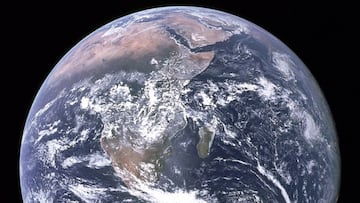Why is Earth's core cooling faster according to scientists?
The Earth’s molten core helps sustain life on our planet, but scientists have discovered it may be cooling faster than predicted. So how long do we have?

We are constantly bombarded with doomsday information about the end of life as we know it. To add to that list, scientists have made a discovery that leads them to believe that heat from Earth’s core may be dissipating faster than previously thought which could have devastating implications.
The discovery came about when ETH Professor Motohiko Murakami and his colleagues from Carnegie Institution for Science managed to measure the thermal conductivity of bridgmanite. This mineral forms the bulk of layer between the Earth’s mantle and its molten core. Bridgmanite’s thermal conductivity is about 1.5 times higher than assumed according to their findings.
Also see:
- Earth's sixth mass extinction has begun according to scientists
- WWF confirm 224 new species of animals and plants discovered
- How chemical pollution threatens species survival
- Most tsunamis happen in the Pacific Ocean, here's why...
- Word games similar to Wordle
How heat from Earth’s core affects life
The Earth has been cooling ever since its formation around 4.5 billion years. In the beginning its was just a ball of molten material but with time the heavier material congregated to the core and lighter materials rose to the surface.
A brittle crust solidified eventually forming into tectonic plates that are the continents and ocean floors. Between the extremely hot core and the crust is the viscous mantle which moves the tectonic plates around which has created the spectacular geographical landscapes we’ve come to know.
Our results could give us a new perspective on the evolution of the Earth’s dynamics.
Professor Motohiko Murakami
The decay of radioactive materials in the iron-nickel core keeps it molten, and heat from which pushes outward toward the surface. The transfer of thermal energy from the core keeps the mantle in a viscous state allowing for plate tectonics and volcanism.
The geodynamo effect of Earth’s interior is the main source of our planet’s magnetic field which shields us from cosmic radiation. It also protects the Earth from radiation and particles emitted by the Sun. Without that protective shield life on Earth would not exist, not only because of the bombardment of radiation but also the atmosphere would be stripped away.
So, if Earth’s core were to cool and solidify, that would stop the constant evolution of the Earth’s surface and worse make life itself on our little blue planet very difficult. The findings by Professor Murakami and his team could mean there needs to be recalculation of just how long until that happens.
ETH Researchers have demonstrated in the lab how well a #mineral common at the boundary between the #Earth’s #core and #mantle conducts heat. This leads them to suspect that the Earth’s interior is cooling faster than expected. @ETH_ERDW @carnegiescience https://t.co/FPbDKH0Dgn
— ETH Zurich (@ETH_en) January 14, 2022
How long until the Earth’s core cools completely?
Since bridgmanite is cooling at a rate faster than previously thought, 1.5 times higher, this gives “a new perspective on the evolution of the Earth’s dynamics,” Professor Murakami told ETH Zurich. This will have a knock-on effect for calculations of heat transfer of the stable mineral phases at the core-mantle boundary.
When bridgmanite cools it converts into another mineral called post-perovskite, which conducts heat even more efficiently. As post-perovskite becomes the dominate mineral in the core-mantle boundary the cooling process could further accelerate. Professor Murakami says the results “suggest that Earth, like the other rocky planets Mercury and Mars, is cooling and becoming inactive much faster than expected.”
We still don’t know enough about these kinds of events to pin down their timing.
Professor Motohiko Murakami
Related stories
Professor Murakami told Newsweek “The time scale that would fit to this discussion should be millions or even billions of years.” Depending on the calculations, the Sun could most likely swallow up our planet before then when it becomes a red giant in some 5 billion years. Likewise, on an average of every 20 million years the Earth is hit by an object, meteor or comet, about the size of the one that is believed to have wiped out the dinosaurs.
More pressing to humanity’s future, and all life as we know it on Earth, is the impact that climate change and humans' impact on the environment are having. A major study by the International Union for Conservation of Nature found that the earth may be on the brink of its sixth mass extinction event.


